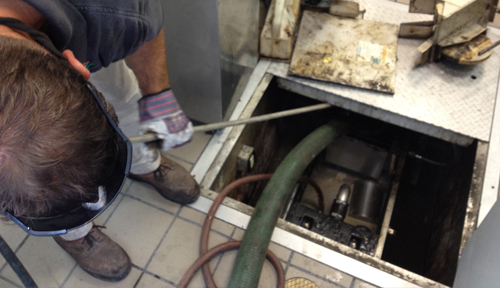How to Clean and Maintain Your Grease Traps

From oily baking sheets, to caked-up skillet, to bubbling deep fryers, there's just no getting around grease: especially in a busy commercial kitchen.
It's standard practice for professional kitchens to be fitted with grease traps – plumbing devices that catch and collect oil and solid fats before they can enter the wastewater disposal system. And although they're fairly simple in design, grease traps do require some maintenance to keep functioning smoothly.
Our grease trap management tips will help your kitchen continue to run like a "well-oiled" machine:
Control Your Grease Disposal
Grease traps are great at keeping oil and chunks of fat out of your pipes and the public sewage system. But they aren't magic – that same runoff that clogs up pipelines will overwhelm your grease trap eventually. When that happens, its effectiveness as a filter is seriously reduced.
Fortunately, grease traps can be cleaned out (we'll get to this soon). But since this process takes time and effort, it's best if you can limit the amount of oil that enters your grease trap in the first place. Secure the drain screens/covers tightly to block solid debris from getting in, and be sure to scrape solidified oil out of pots/pans before washing.
New employees should receive training in your kitchen's grease disposal management processes. It may also be helpful to post signs by kitchen sinks reminding employees to keep fats out of the drain whenever possible.
Cooking Oil – Save, Don't Dump!
If you didn’t already know, cooking oil has become quite the commodity in itself – used in manufacturing soaps, detergents, even biodiesel fuel. Make the effort to recycle it! You'll be protecting the plumbing while also turning that kitchen "waste" into a brand-new revenue stream.
If that's not enough motivation, know that many cities and townships have strict regulations on how cooking oils are disposed of. Because grease can be harmful to pipes, sewage systems, and drainage fields, simply dumping it down the drain can result in hefty fines – or worse.
Note that unlike "yellow grease" that comes straight from the fryer, oil removed from grease traps (or "brown grease") generally contains rotted food solids and is not often fit for recycling. So remember to set aside oil before cleaning your cookware and appliances, preferably in a dedicated bucket or other container.
Have Your Grease Traps Professionally Cleaned
Staying on top of your grease traps' status – not to mention the complex municipal standards on grease disposal – can be tough for busy restaurant owners/managers. The easiest way to handle it, by far, is to work with a professional grease collection and grease trap cleaning service.
How often do grease traps need cleaning? It depends on how busy your kitchen is, what kinds of food you prepare, and how well your staff is doing at limiting the amount of grease that enters the drain. But as a rule of thumb, every 1-3 months is a good timeline for most professional kitchens.
Remember to record your cleaning appointments in a waste manifest, tracking the date of each one along with how much grease was pumped out. Doing so will help you optimize how often you schedule new appointments and limit unnecessary expenses.
For grease trap cleaning, cooking oil recycling, and other professional kitchen solutions with an eco-friendly approach, there’s only one Grand Natural. Contact us online or call (855) 519-5550 today for more information.
categories
Recent Posts
Waste Cooking Oil Recycling Uses & Ideas
2022-04-18 07:00:00
Benefits of Purifying Used Cooking Oil
2022-04-13 07:00:00
5 benefits of recycling used cooking oil
2021-07-30 07:00:00
Things You Need to Know About Used Cooking Oil Collection
2021-07-30 07:00:00
Getting Set Up is Easy.Call UsSign Up NowORCall Us Today. (855) 519-5550



